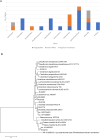Occurrence and expression of genes encoding methyl-compound production in rumen bacteria
- PMID: 33499937
- PMCID: PMC7807696
- DOI: 10.1186/s42523-019-0016-0
Occurrence and expression of genes encoding methyl-compound production in rumen bacteria
Abstract
Background: Digestive processes in the rumen lead to the release of methyl-compounds, mainly methanol and methylamines, which are used by methyltrophic methanogens to form methane, an important agricultural greenhouse gas. Methylamines are produced from plant phosphatidylcholine degradation, by choline trimethylamine lyase, while methanol comes from demethoxylation of dietary pectins via pectin methylesterase activity. We have screened rumen metagenomic and metatranscriptomic datasets, metagenome assembled genomes, and the Hungate1000 genomes to identify organisms capable of producing methyl-compounds. We also describe the enrichment of pectin-degrading and methane-forming microbes from sheep rumen contents and the analysis of their genomes via metagenomic assembly.
Results: Screens of metagenomic data using the protein domains of choline trimethylamine lyase (CutC), and activator protein (CutD) found good matches only to Olsenella umbonata and to Caecibacter, while the Hungate1000 genomes and metagenome assembled genomes from the cattle rumen found bacteria within the phyla Actinobacteria, Firmicutes and Proteobacteria. The cutC and cutD genes clustered with genes that encode structural components of bacterial microcompartment proteins. Prevotella was the dominant genus encoding pectin methyl esterases, with smaller numbers of sequences identified from other fibre-degrading rumen bacteria. Some large pectin methyl esterases (> 2100 aa) were found to be encoded in Butyrivibrio genomes. The pectin-utilising, methane-producing consortium was composed of (i) a putative pectin-degrading bacterium (phylum Tenericutes, class Mollicutes), (ii) a galacturonate-using Sphaerochaeta sp. predicted to produce acetate, lactate, and ethanol, and (iii) a methylotrophic methanogen, Methanosphaera sp., with the ability to form methane via a primary ethanol-dependent, hydrogen-independent, methanogenesis pathway.
Conclusions: The main bacteria that produce methyl-compounds have been identified in ruminants. Their enzymatic activities can now be targeted with the aim of finding ways to reduce the supply of methyl-compound substrates to methanogens, and thereby limit methylotrophic methanogenesis in the rumen.
Keywords: Bacterial; Methanol; Methyl-compound; Methylamines; Rumen.
Conflict of interest statement
The authors declare that they have no competing interests.
Figures




References
Grants and funding
LinkOut - more resources
Full Text Sources
Molecular Biology Databases
